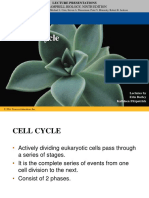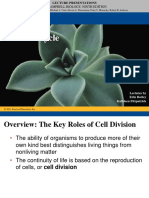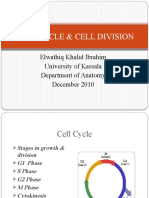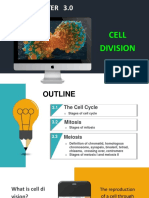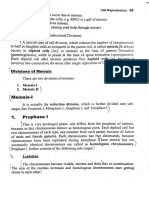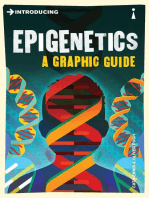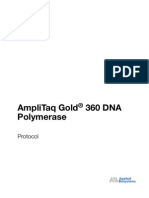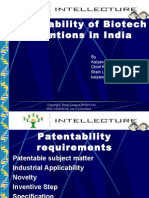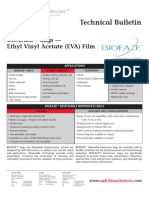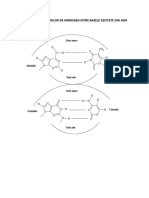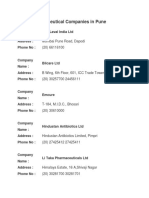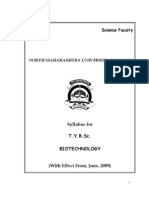0 ratings0% found this document useful (0 votes)
75 viewsBIO150 Chapter 4 Cell Division
BIO150 Chapter 4 Cell Division
Uploaded by
Yuu ShaThis document summarizes key concepts related to cell cycle, protein synthesis, and nucleic acids. It discusses the stages of mitosis and meiosis, including their phases and differences. It also covers the basic components and replication of DNA, as well as the process of gene expression and protein synthesis. The three main models of DNA replication are described, with semiconservative replication identified as the most accepted.
Copyright:
© All Rights Reserved
Available Formats
Download as PDF, TXT or read online from Scribd
BIO150 Chapter 4 Cell Division
BIO150 Chapter 4 Cell Division
Uploaded by
Yuu Sha0 ratings0% found this document useful (0 votes)
75 views1 pageThis document summarizes key concepts related to cell cycle, protein synthesis, and nucleic acids. It discusses the stages of mitosis and meiosis, including their phases and differences. It also covers the basic components and replication of DNA, as well as the process of gene expression and protein synthesis. The three main models of DNA replication are described, with semiconservative replication identified as the most accepted.
Original Title
BIO150 Chapter 4 cell division
Copyright
© © All Rights Reserved
Available Formats
PDF, TXT or read online from Scribd
Share this document
Did you find this document useful?
Is this content inappropriate?
This document summarizes key concepts related to cell cycle, protein synthesis, and nucleic acids. It discusses the stages of mitosis and meiosis, including their phases and differences. It also covers the basic components and replication of DNA, as well as the process of gene expression and protein synthesis. The three main models of DNA replication are described, with semiconservative replication identified as the most accepted.
Copyright:
© All Rights Reserved
Available Formats
Download as PDF, TXT or read online from Scribd
Download as pdf or txt
0 ratings0% found this document useful (0 votes)
75 views1 pageBIO150 Chapter 4 Cell Division
BIO150 Chapter 4 Cell Division
Uploaded by
Yuu ShaThis document summarizes key concepts related to cell cycle, protein synthesis, and nucleic acids. It discusses the stages of mitosis and meiosis, including their phases and differences. It also covers the basic components and replication of DNA, as well as the process of gene expression and protein synthesis. The three main models of DNA replication are described, with semiconservative replication identified as the most accepted.
Copyright:
© All Rights Reserved
Available Formats
Download as PDF, TXT or read online from Scribd
Download as pdf or txt
You are on page 1of 1
CHAPTER 4 By Wan Nur Ayu Shalina binti Mohd Yusni (2020472294)
CELL CYCLE & PROTEIN SYNTHESIS
CHROMOSOME consist of chromatin, a complex of DNA MEIOSIS TWO TYPES OF NUCLEIC ACIDS
and protein called Histones that condenses during cell • Division of cell that produce 4 daughter -DNA (deoxyribonucleic acid)
division cell -RNA (ribonucleic acid)
MITOSIS • Genetic content is different from mother
• Division of cell that produce 2 daughter cell
BASIC COMPONENT OF NUCLEIC ACID
cell 1. 5 carbon sugar (Deoxyribose or Ribose)
• Daughter cell genetically identical to the STAGES IN MEIOSIS
2. Nitrogenous base ((A) Adenine , (T) Thymine ,
mother cell • Interphase consist of G1 phase, S phase,
(G)Guanine, (C) Cytocine , (U) Urasil )
• Chromosome number of daughter cell G2 phase.
3. Phosphate group
same with the mother cell. • Consist of 2 stages called meiosis I and
meiosis II
PHASES OF CELL CYCLE MITOSIS • Meiosis I (separation of homologous DNA replicate during interphase – S phase (synthesis)
• Interphase consist of G1 phase, S phase, chromosome)
G2 phase • Meiosis II (separation of chromatid sister)
• Mitotic phase consist of mitosis(P,M,A,T) MODEL OF DNA REPLICATION DNA REPLICATION
and cytokinesis MEIOSIS I AND MEIOSIS II CONSIST OF 1. Conservative model Is a process of copying a
P,M,A,T 2. Semiconservative model double-stranded DNA strand.
P=PROPHASE 3. Dispersive model
HOMOLOGOUS CHROMOSOME , two
M=METAPHASE STEPS IN DNA REPLICATION
chromosome composing a pair that have the
A=ANAPHASE Most accepted model = -Initiation
same length , centromere position , and both
T=TELOPHASE semiconservative model -Elongation
carry genes controlling the same inherited
characters. -Termination
DIFFERENCES BETWEEN BETWEEN MITOSIS
IN ANIMAL AND PLANT This terms is used when explain Meiosis I
PROCESS SYNTHESIS FROM GENE TO PROTEIN
PLANT ANIMAL
• No centriole and aster • Have centriole and aster
• Cytokinesis involve the • Cytokinesis involve the
formation of cell plate formation of cleavage furrow
• Occur in meristematic cell • Occur in somatic cell
You might also like
- Chapter 6 Cell DivisionDocument51 pagesChapter 6 Cell DivisionAA ProductionNo ratings yet
- Botany NotesDocument9 pagesBotany NotesArcelle BraganzaNo ratings yet
- IBW 13 Mitosis AJ 23Document40 pagesIBW 13 Mitosis AJ 23graceadelinefessaNo ratings yet
- 99a Genetics Student Workbook Summer 2021Document33 pages99a Genetics Student Workbook Summer 2021Nicole Xie [Student]No ratings yet
- 3.0 Cytology-CELL CYCLE UphmoDocument43 pages3.0 Cytology-CELL CYCLE UphmoPatrick DingcoNo ratings yet
- 10 PPT Cell DivisionDocument33 pages10 PPT Cell DivisionaryanpandadpsntNo ratings yet
- Cell Cycle, Mitosis, MeiosisDocument34 pagesCell Cycle, Mitosis, Meiosisroylene mae samontinaNo ratings yet
- Cell Cycle and MitosisDocument122 pagesCell Cycle and MitosisRonel Paul HibayaNo ratings yet
- BiologyDocument12 pagesBiologyfloresstephaniejoycNo ratings yet
- Laboratory Class: Biology (BT155IU)Document15 pagesLaboratory Class: Biology (BT155IU)Lý Huệ LinNo ratings yet
- Biotech 3 Cell DivisionDocument4 pagesBiotech 3 Cell DivisionClinton YmbongNo ratings yet
- Lecture 4 Cell Cycle and Mitosis (Autosaved)Document73 pagesLecture 4 Cell Cycle and Mitosis (Autosaved)scdantolinoNo ratings yet
- Cell Cycle, Mitosis and MeiosisDocument19 pagesCell Cycle, Mitosis and MeiosisSaadNo ratings yet
- GENETICS LectureDocument27 pagesGENETICS LectureHanna Beth Butiong TandayagNo ratings yet
- Mitosis and Meiosis InfographDocument1 pageMitosis and Meiosis InfographPatricia BonganayNo ratings yet
- Form 4 Science Cell DivisionDocument39 pagesForm 4 Science Cell Divisionummi zNo ratings yet
- Znotes OrgDocument3 pagesZnotes OrgSandra AtefNo ratings yet
- Siklus Sel Dan Pembelahan SelDocument99 pagesSiklus Sel Dan Pembelahan SelRenika Dwi WahyuniNo ratings yet
- Chap 2Document31 pagesChap 2rishabhmehta2008No ratings yet
- Mitosis, Meiosis PPT 1Document38 pagesMitosis, Meiosis PPT 1issacabhishekdaraNo ratings yet
- Living Organisms Reproduce by Two Methods: Asexual ReproductionDocument36 pagesLiving Organisms Reproduce by Two Methods: Asexual ReproductionMary SiddNo ratings yet
- Interphase: Haploid Cells With Unreplicated ChromosomesDocument16 pagesInterphase: Haploid Cells With Unreplicated ChromosomesAllen Ray Lopez SaclagNo ratings yet
- Biology Partial Exam 3 SummariesDocument11 pagesBiology Partial Exam 3 SummariesJuan DavidNo ratings yet
- Session No. 1.3. Cell Cycle and Cell DivisionDocument43 pagesSession No. 1.3. Cell Cycle and Cell DivisionShekaina Faith Cuizon LozadaNo ratings yet
- Genetics 2019Document151 pagesGenetics 2019Joycee Jatulan-EnajeNo ratings yet
- Heredity and Variation Grade 9Document45 pagesHeredity and Variation Grade 9Isabella EstebanNo ratings yet
- Cell cycle and Cell divisionDocument26 pagesCell cycle and Cell divisionsendpics.rhNo ratings yet
- Chapter 6 Cellular ReproductionDocument22 pagesChapter 6 Cellular Reproductionnguyenminhhuyen.workNo ratings yet
- MeiosisDocument8 pagesMeiosisRohit MaldeNo ratings yet
- Agr 232 - Chapter 1 - Introduction To Plant PropagationDocument70 pagesAgr 232 - Chapter 1 - Introduction To Plant Propagation2024916775No ratings yet
- Genbio Reviwer FinalsDocument5 pagesGenbio Reviwer FinalsChesley CarolinoNo ratings yet
- BIO 30 - Lec 2 Chromosomal Basis 2020bDocument36 pagesBIO 30 - Lec 2 Chromosomal Basis 2020bap1pleNo ratings yet
- Bio LaboratoryDocument4 pagesBio Laboratorys.merla.janchristianNo ratings yet
- MeiosisDocument56 pagesMeiosisMarija PetrovicNo ratings yet
- Cell Cycle & DivisionDocument44 pagesCell Cycle & DivisionWathiq Khalid IbrahimNo ratings yet
- CellsDocument44 pagesCellsRuthie MendozaNo ratings yet
- Cell Division LatestDocument20 pagesCell Division LatestThivya SritharNo ratings yet
- Chapter 4 - Cell Division - Part 1Document92 pagesChapter 4 - Cell Division - Part 1happyflowerNo ratings yet
- Cell Growth and DivisionDocument13 pagesCell Growth and DivisionmunozayshiaNo ratings yet
- 2 Mitosis Vs MeiosisDocument21 pages2 Mitosis Vs MeiosisKinjNo ratings yet
- Meiosis and MitosisDocument22 pagesMeiosis and Mitosisyaqoob008No ratings yet
- ? ???? ?????? ??? ?????? ?Document4 pages? ???? ?????? ??? ?????? ?Irene G.No ratings yet
- romosomes-cellcycle-dnareplication-genome-generegulationDocument10 pagesromosomes-cellcycle-dnareplication-genome-generegulationvedanacatherine63No ratings yet
- MEIOSISDocument2 pagesMEIOSISKim BeatrizNo ratings yet
- Cell Cycle and MitosisDocument16 pagesCell Cycle and MitosisElah TapangNo ratings yet
- Bio11 Campbell Chapter 12Document4 pagesBio11 Campbell Chapter 12ChristineNo ratings yet
- Chapter Two Cell Cycle and CommunicationDocument80 pagesChapter Two Cell Cycle and Communicationkhaledabuzer100No ratings yet
- Meiosis: Cell DivisionDocument21 pagesMeiosis: Cell DivisionAthena AretaNo ratings yet
- 4th Module 2 Cel ReproductionDocument57 pages4th Module 2 Cel ReproductionLocal ClownNo ratings yet
- 3meiosis One Pager Eng MemoDocument1 page3meiosis One Pager Eng Memoisenathifekisi1No ratings yet
- 3 ScanDocument5 pages3 ScanAsadNo ratings yet
- Finals BiolecDocument21 pagesFinals BiolecRodney Lemuel FortunaNo ratings yet
- GB2 Asexual ReproductionDocument23 pagesGB2 Asexual Reproductionsja254677No ratings yet
- Genbio Reviwer FinalsDocument6 pagesGenbio Reviwer FinalsChesley CarolinoNo ratings yet
- Cell DivisionDocument49 pagesCell DivisionAngelyn AbuevaNo ratings yet
- The Cell Cycle: For Campbell Biology, Ninth EditionDocument51 pagesThe Cell Cycle: For Campbell Biology, Ninth EditionBelenNo ratings yet
- Genetics NotesDocument28 pagesGenetics NotesjasNo ratings yet
- Science8WS Q4 Week2Document11 pagesScience8WS Q4 Week2Desiree Tuares LotasNo ratings yet
- Gene Editing, Epigenetic, Cloning and TherapyFrom EverandGene Editing, Epigenetic, Cloning and TherapyRating: 4 out of 5 stars4/5 (1)
- Flashcards For Neet Biology 12 Biotechnology Principles and Processes PDFDocument5 pagesFlashcards For Neet Biology 12 Biotechnology Principles and Processes PDFDeepikaNo ratings yet
- UC2013 Umetrics PetterMoree ApplicationsOfMultivariateDataAnalysisDocument31 pagesUC2013 Umetrics PetterMoree ApplicationsOfMultivariateDataAnalysisBlank BacktobasicNo ratings yet
- Construction of Phylogenetic TreeDocument12 pagesConstruction of Phylogenetic TreeKris ManuelNo ratings yet
- List of Medicinal ProductsDocument10 pagesList of Medicinal ProductsFandossituNo ratings yet
- BIOL 1005 Final Study GuideDocument3 pagesBIOL 1005 Final Study GuideJjNo ratings yet
- Forensic DNA Analysis Y-STRDocument10 pagesForensic DNA Analysis Y-STRWawan BwNo ratings yet
- Amplitaq Gold 360 Dna Polymerase: ProtocolDocument46 pagesAmplitaq Gold 360 Dna Polymerase: Protocolalle8625No ratings yet
- PDFDocument168 pagesPDFrsudhakaran80No ratings yet
- Indian Company Listxls - CompressDocument378 pagesIndian Company Listxls - CompressUday kumarNo ratings yet
- Bioinformatics PDFDocument125 pagesBioinformatics PDFChris GenusNo ratings yet
- Lecture 4Document21 pagesLecture 4PEARL BEATRICE GONZALESNo ratings yet
- Pellicon 3 Biomax DS1324EN00 6 MMDocument10 pagesPellicon 3 Biomax DS1324EN00 6 MMrodri691994No ratings yet
- Lecture-3/ Presentation On Patentability of Biotech Inventions in IndiaDocument13 pagesLecture-3/ Presentation On Patentability of Biotech Inventions in IndiabrainleagueNo ratings yet
- Ciba SandoDocument14 pagesCiba SandolmcNo ratings yet
- Neumaier 1998 Fundamentals Quality Assessment Molecular Ampli MethodDocument15 pagesNeumaier 1998 Fundamentals Quality Assessment Molecular Ampli MethodMaya RustamNo ratings yet
- PET System TutorialDocument5 pagesPET System TutorialSaffronDingNo ratings yet
- SAFC Biosciences - Technical Bulletin - BIOEAZE Bags - Ethyl Vinyl Acetate (EVA) FilmDocument4 pagesSAFC Biosciences - Technical Bulletin - BIOEAZE Bags - Ethyl Vinyl Acetate (EVA) FilmSAFC-Global100% (1)
- SD 2 R 5Document1 pageSD 2 R 5Orsu HarishNo ratings yet
- Synthetic Biology PracticalDocument33 pagesSynthetic Biology PracticalChandra PradhitaNo ratings yet
- (Methods in Molecular Biology 1296) Mathieu Rederstorff (Eds.) - Small Non-Coding RNAs - Methods and Protocols-Humana Press (2015) PDFDocument239 pages(Methods in Molecular Biology 1296) Mathieu Rederstorff (Eds.) - Small Non-Coding RNAs - Methods and Protocols-Humana Press (2015) PDFMe100% (1)
- Formarea Legăturilor de Hidrogen Intre Bazele Azotate Din AdnDocument7 pagesFormarea Legăturilor de Hidrogen Intre Bazele Azotate Din AdnAnca EmiliaNo ratings yet
- Genetically Modified OrganismsDocument5 pagesGenetically Modified OrganismsCzad Fered GilhangNo ratings yet
- Botany SyllabusDocument34 pagesBotany SyllabusVivek Ananth R P100% (2)
- Branches of BiologyDocument8 pagesBranches of BiologyholykwakamowlyNo ratings yet
- International Service For The Acquisition of Agri-Biotech Applications, Inc., Et. Al. v. Greenpeace Southeast Asia (Philippines), Et - Al. (BT Talong Case) - DigestDocument8 pagesInternational Service For The Acquisition of Agri-Biotech Applications, Inc., Et. Al. v. Greenpeace Southeast Asia (Philippines), Et - Al. (BT Talong Case) - DigestJJMO93% (15)
- CIP Cycle Development ISPEDocument9 pagesCIP Cycle Development ISPEvijayns_250355172No ratings yet
- List of Pharmaceutical Companies in PuneDocument5 pagesList of Pharmaceutical Companies in PuneMain Sanatani HunNo ratings yet
- Statement of PurposeDocument2 pagesStatement of PurposeAshwin SinghNo ratings yet
- 2009-10 T.Y.B.Sc. BiotechnologyDocument18 pages2009-10 T.Y.B.Sc. BiotechnologyStacy Sabrina VazNo ratings yet
- JNTU Old Question Papers 2007Document6 pagesJNTU Old Question Papers 2007Srinivasa Rao GNo ratings yet







